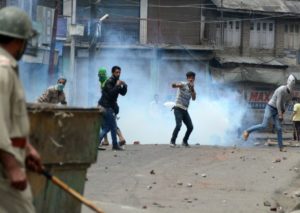
The UPA’s failure to reach out to the Kashmiris and the NDA’s ‘anti-Muslim’ stance has fuelled anger in the Kashmir valley, observes Ajai Shukla.The government’s silence in the face of simmering anger in Kashmir is throwing into dangerous confrontation two crucial protagonists — the army versus unarmed Kashmiri civilian mobs.The army, on the one hand, must intensify counter-infiltration operations to keep militants at bay until snow closes routes across the Line of Control.And with nothing to show for months of violent street protests after the killing in July of popular local militant Burhan Wani, Kashmiri separatists have little choice but to up the ante, if necessary by confronting the army directly.On Wednesday, February 15, a day after four army men were killed and several others injured in three encounters in North Kashmir, army chief General Bipin Rawat bluntly warned that stone-pelting Kashmiri mobs who interfered in army operations would be fired upon.Calling such mobs ‘over-ground workers of the terrorists’, General Rawat also warned that civilians waving Pakistani or Islamic State flags would be treated as ‘anti-nationals.’These strong words had been carefully calibrated.The army, highly experienced in counter-insurgency operations, faces a worrying new challenge from flash mobs of Kashmiri civilians, who hurl stones at soldiers moving to cordon a suspected militant hideout, or closing in for the final engagement.This facilitates the militants’ getaway. Alternatively, like on Tuesday, it distracts soldiers at a critical moment, causing additional casualties.Since insurgency broke out in the Kashmir valley in 1990, even through sustained spells of violent civilian protests, mobs had prudently avoided direct confrontation with the army and its counter-militancy wing, the Rashtriya Rifles.Keeping Kashmir, but losing the Kashmiris
Most seminal confrontations with civilians have involved the central armed police forces, CAPFs, or the J&K police, JKP.From the bloodbath in Srinagar in May 1990, when some 50 Kashmiri mourners at Mirwaiz Mohammed Farooq’s funeral procession were shot dead by a panic-stricken Central Reserve Police Force detachment that feared it was being overwhelmed to the three summers of violent street protests across Kashmir in 2008, 2009 and 2010, it was always CAPFs or JKP that came into direct confrontation with civilian mobs.Even through periods of extended bitterness, the army and civilians extended unusual courtesies to each other.Army posts were seldom directly targeted and army convoys moved with relative freedom.There were two reasons for this. First, violent civilian mobs were largely an urban phenomenon; and the police, not the army, controlled the valley’s big cities.Second, Kashmiri separatist leaders realised there would be bloody costs to directly confronting the army, since that would be responded to, not as civilian protest, but as a threat to the territorial integrity of the Line of Control, which the army guarded.Few Kashmiris would admit this, but there is a grudging public respect of the army’s operational restraint and ‘winning hearts and minds’ campaigns that have materially uplifted living conditions in remote border areas ignored by the state government.This balance, however, began changing in 2014-2015, when the first civilian flash mobs appeared in rural South Kashmir and challenged ongoing army cordon-and-search operations.Inexorably, incidents grew of unarmed locals pelting stones at armed soldiers in cordons and of interference in actual firefights.This mindset change across rural Kashmiris is blamed on two reasons.Firstly, after the mass agitations of 2008-2010, Kashmiris expected an outreach from New Delhi, including a political dialogue.
Not only did the United Progressive Alliance betray that expectation, but, since 2014, the National Democratic Alliance government inflamed Kashmiri opinion with ‘anti-Muslim’ confrontations like the beef ban, the Dadri lynching and the ‘love jihad’ controversy.
As bitterly resented were a series of local controversies, internal to Kashmiri politics, that separatists presented as an assault on the Kashmiri identity — such as allegations that New Delhi was transforming the valley’s demographic profile by sponsoring ‘Pandit Colonies’ and ‘Sainik Colonies’.
Sinha to Modi: ‘You need to take bold steps in Kashmir!’
Further, Kashmiri youth were bitter at the abject failure of armed militancy, with new militants often surviving less than a month in the field before being gunned down by the security forces.
The frenzy after the gunning down of Burhan Wani last July, more a social media star than a dreaded militant, reflected public bitterness at an underdog swallowed by the maws of a pitiless security establishment.
Many of those pelting stones at an army cordon are driven by the frantic need to rescue a young man whom they know intimately.
The army, however, does a dangerous job, in which it already imposes numerous restraints on itself to make COIN operations less hazardous to the public — such as abjuring the use of mortars, artillery, helicopters or air power.
Senior commanders realise that soldiers’ hands cannot be tied beyond a point.Hence, General Rawat’s warning to civilians, which is not the first.
Last April, after a dozen soldiers were injured in stone pelting, the army publicly warned it would use force against civilians breaking a cordon. Earlier, two civilians were actually killed near Pulwama while they attacked an army cordon.
“We have painted the Kashmiri youngsters into a dangerous corner. The only way of relieving the pressure is dialogue. Otherwise, this will not end well,” says a senior military officer serving in the valley.

